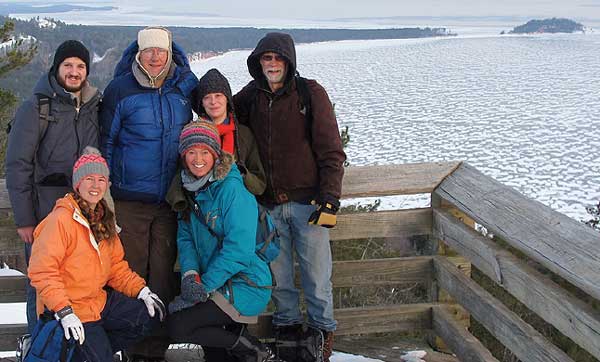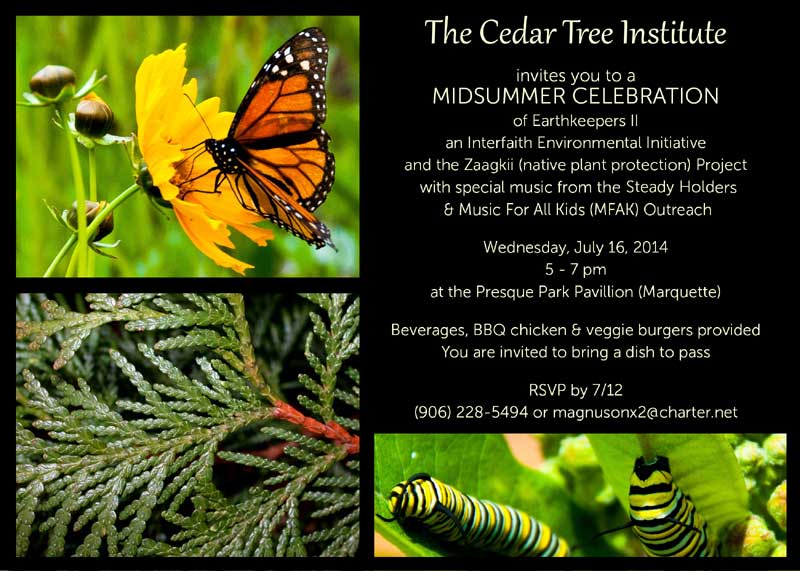Seasonal Notes from the Cedar Tree Institute
Judith Orloff, a psychiatrist and healer, insightfully points out the importance of what she calls “The Golden Stitch.” She’s referring to unnoticed acts of grace and kindness, courage and beauty that, when all is said and done, hold the universe together. Orluff suggests, as a Galilean carpenter also did, such moments are all around us, but only if we have eyes to see. Not long ago I witnessed such a moment. Years of working with diverse organizations have convinced me that popular glittering gods of power, politics, and achievement, ecclesiastical or secular, will always remain incapable of recognizing such gentle magic.
The initial call came in January from Tim, a social worker and close friend of The Cedar Tree Institute. Deep in the frozen woods of Michigan’s Upper Peninsula, he works on an Alzheimer’s unit for a nursing home in a small community where a state mental hospital, once abandoned, is now a maximum-security prison. High razor wire fences mark its presence near the town’s boundary. Two years ago, a forest fire raged north of the county line, only miles from the town, destroying thousands of acres along Ernest Hemingway’s beloved Two-hearted River.
The phone message he left on the answering machine was brief. “Lorraine is here, a patient,” it began. “Her husband Art visits regularly, remains by her side. I mentioned your name. Their eyes lit up. They said you officiated at their wedding 37 years ago. They asked if there would be any chance you could take the two-hour drive over to renew their marriage vows.”
So it happened. On February 3rd, at the end of the afternoon shift, Lorraine, Art, their pastor Jesse Brown and I gathered together with Tim and thirty residents and friends in the Golden Leaves Nursing Home Community Room. Kitchen staff, custodians, nurses and residents, several in wheelchairs, many with dementia, surrounded us. The pastor and his wife brought along their four-year old twin girls Evelyn and Elizabeth.
Art had saved the original wedding homily (a poem) I had written. He carried it that afternoon folded in his pocket. Lorraine was dressed in white, holding a small bouquet of daisies with both hands.
Memories returned. At the little church in the tiny commercial fishing village of Brevort, a mechanic and his bride walked down the steps as a small gathering of a dozen friends, family and congregation members threw handfuls of birdseed over their heads. Lorraine carried a bouquet of daisies they had picked from a meadow earlier that afternoon. After a drive down a gravel road to a wood-framed range hall, my wife Diana and I entered the gathering room. Sawdust was scattered over the floor. Fiddlers begin to play.
Back at the nursing home, at the end of the brief service, I asked, out of curiosity, if Art remembered how much their wedding cost. He said softly, “We’ve never had much money. It’s never been that important to us. We’ve lived for the last few years in tribal housing, that’s helped. We’ve always had to be careful, with jobs coming and going. I think it was about $150. That included the gift to the church, a few dollars for musicians, food for the reception.”
On the drive back home, I traveled down the Seney Stretch, a dangerous patch of road where several of my friends have died in rough weather accidents over the years. I thought about the gift of human love, the uneven, rough, unexpected roads that life unfolds for all of us, and the courageous commitment of two people. Of a splendid power in that odd group of us, mostly strangers to one another, who chose to gather together that afternoon, in mostly a forgotten place, to honor long ago made promises framed with prayer and song.
The weather that entire day was cold, hard. The return was lonely, with little traffic. An abandoned, rusted railroad track ran parallel to the highway. Heading west, driving through winter’s shadows spreading out from miles of dark, ragged roadside jack pine, I glimpsed the sun. Golden splintered light, streaming before me.
– JWM
CONTENTS
- EarthKeepers II
- Wings & Seeds Initiative
- Notes from a Religious Life
- Workshops & Programs
- In Memoriam
- Music for all Kids
- CTI’s Upper Peninsula Index
EARTH KEEPERS II: UPDATE
An Interfaith Environmental Initiative
Thank you, Joe Johnson, our over-the-top volunteer from Eden Lutheran Church in Munising. Joe is following up on 40 USEPA-funded energy conservation projects with congregations across the Upper Peninsula and Northeast Wisconsin.
Kyra Ziomkowski, EK Project Coordinator, will soon be back after some weeks welcoming her and Robert’s new little boy Robert Roscoe Achilles Goodrich, born 3/2/14. Our gratitude to Heidi Gould who’s been serving as interim coordinator.
On 3/10/11, Larry Rasmussen, nationally known ethicist and Professor Emeritus from Union Seminary in New York, made three presentations in Marquette and Ishpeming. Close to 200 community leaders, university students, and clergy joined us for presentations and workshops around the theme: “A Planet in Crisis: Faith, Ethics and the Environment.”

We’re now moving forward, with good energy, to reach our goal for our community garden initiative: to establish 40 gardens, supported by faith communities across the Upper Peninsula in 2014. Read more about the history and goals of Earthkeepers on our website: www.earthkeepersup.org
THE ZAAGKII PROJECT
WINGS & SEEDS INITIATIVE
Th is initiative, coordinated by e Cedar Tree Institute, the U.S. Forest Service and five American Indian tribes moves into its 6th year. A central focus is to lift up and educate the pubic about the importance of recovering and protecting Native plants and pollinators.
Jan Schultz, Chief Botanist for the Eastern Region of the U.S. Forest Service, Scott Herron, ethnobotanist, and Tom Biron, member of the Sault Ste Marie Band of Chippewa Indians, serve as key strategists for this effort.

The 4/14 issue of The Marquette Monthly features an article on pollinators written and illustrated by Diana Magnuson. She reminds us that, for some, this may be a local and regional e ort, but it holds global implications for the healing of a broken planet. Learn more at: www.marquettemonthly.com
NOTES ON A RELIGIOUS LIFE
CTI’s Director and NMU student Katelin Bingner provided leadership for worship services at Holy Trinity Lutheran Church in Chassell, Michigan on 3/15/14.
During January and February, four individuals undergoing chemotherapy met quietly and con dentially for seven weeks to address health and illness issues. A joint project of Messiah Lutheran Church and the Cedar Tree Institute, The St. Luke Project, co-led by Jim Shirtz, appropriated strategies from faith traditions with tested practices from mind/body medicine to help counter emotional and physical challenges of invasive cancer treatments. Th anks to physicians Cary Bjork and Larry Skendzel who served as resources.
On 4/2, the CTI Director will serve as guest speaker for the Messiah Lutheran Church Lenten Series. On 6/21, he is scheduled to o ciate at the wedding of Tyler Jenema and Monica Markvardsen.
WORKSHOPS & PROGRAMS
- Spirit of Place, a kayak retreat along Lake Superior. Topic: “The Prophetic Imagination of Flannery O’Conner”
- August, 4 -8
- The Iron Butterfly: A Workshop on Mind/Body Medicine
- June 19
- Cedar Tree Summer Festival: “A Celebration of Pollinators”
- July 16
- The Autumn Janus Project: A Training for Hospice Workers
- September 26-28
- Crossing Boundaries: Dilemmas of Economics & Social Class for Parish Life. Clergy/ Faith-based leaders workshop
- May (TBA)
- Ongoing weekly Tai Chi classes
- April through May

IN MEMORIAM:
MICHAEL NUTINI 1947-2014
When you climb the back porch steps to The Cedar Tree Institute on E. Michigan St., you’ll step on the carpentry work of Michael Nutini. On 2/24, Michael, a decorated Vietnam veteran, part-time building contractor, a descendent of Italian immigrants to Northern Michigan’s mining country, father of two sons, unabashed recovering alcoholic and personal friend of Gordon Lightfoot (that’s a story in itself), died in a motor vehicle accident on an icy winter county road in the Keweenaw Peninsula.
At his funeral Mass at Church of the Resurrection in Hancock, a booklet of children’s drawings was set on a table near the sanctuary door. It was compiled the day before; a gift from “Mrs. Anderson’s Kindergarten Class.” Mike volunteered at his youngest son’s (Santino) school. On the last page, under a drawing of a shoe, were these crayon-scrawled words. “Thank you, Mr. Nutini, for helping me learn to tie my shoes.”
That’s as good as it will probably get. For any of us.
MUSIC FOR ALL KIDS
A program providing music lessons by local instructors for youth who might otherwise would not be able to afford them. In partnership with CTI. For more information contact: Shane Murray 906-235-5163 www.music4allkids.us
CTI’S UPPER PENINSULA INDEX
- Customers attending the weekly Saturday farmers’ market, in Marquette, on average: 682
- Percentage of market customers that also shop at downtown businesses during the market: 87
- Amount, in dollars, Escanaba plans to invest to expand its farmers market: 532,000
- Acres of land J.M. Longyear sold to aspiring U.P. farmers nearly a century ago: 250,000
- Percentage of ice cover on lakes Superior and Michigan in early March, respectively: 95.5, 90.5
- Dead ducks found by one biologist that starved due to the Great Lake’s heavy ice cover: 950
- Percentage of residents that think Baraga County’s economy is in a “desperate” situation: 75.8
- Percentage of western U.P. children living in poverty: 25
- Annual visitors to the Keweenaw National Historical Park & Heritage Sites: 240,000
- Amount, in dollars, Congress plans for development and environmental cleanup at the park: 26,000,000
- Number of days below zero in Iron River this winter (a new record): 74
- Number of U.P.ledge-leaping, forest roaming grandchildren born to Jon & Diana Magnuson 3/6/14: 1
- Percentage of western U.P. residents told by a doctor they had a depressive disorder: 24.2
- Amount, in dollars, the U.S. government spent protecting a U.P. farmer’s cattle: 200,000
- Cows this farmer – in court for animal cruelty – claimed to be lost to wolves since 2010: 96
- His share of the statewide total, as a percentage: 61
Our mission is to contribute quietly to the Common Good. The Cedar Tree Institute owns no property and has no full time employees. We choose not to compete with United Way agencies or local faith communities for limited financial resources. We carry on this work, thanks to small grants and donations by residents in Michigan’s Upper Peninsula and to individuals, some as distant as New Mexico, Hawaii, Washington State, and New York.
To you our deepest appreciation!
The Spring 2014 Equinox Newsletter is brought to you by Cedar Tree Institute.




